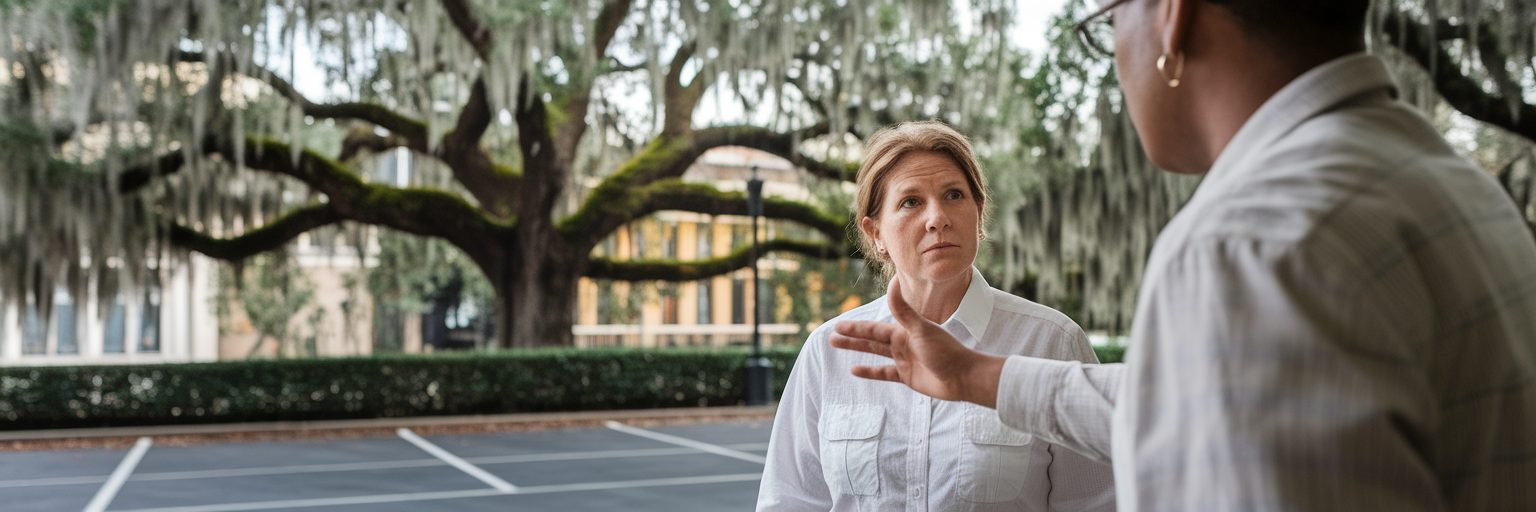Defining Negligence in a Parking Lot Environment
Anyone who has tried to find a parking spot near the Charleston City Market on a weekend or navigated the lots at Folly Beach on a summer day knows the feeling. It’s a chaotic mix of cars pulling in and out, families unloading gear, and people walking between vehicles. This constant motion is precisely why drivers are held to a higher standard of care in parking lots compared to open roads.
Legally, every driver has a “duty of reasonable care” to avoid harming others. In a parking lot, this duty becomes more demanding. Drivers must anticipate unpredictable pedestrian traffic, including children who might dart out from between cars, and account for obstructed sightlines. Simply following the speed limit isn’t enough; vigilance is required.
When a driver fails in this duty and causes an injury, it may constitute negligence. However, proving negligence in a car accident requires more than just showing an accident happened. You must establish four specific legal elements. Understanding these pillars is the first step toward building a solid claim.
| Element | Definition | Charleston Parking Lot Example |
|---|---|---|
| Duty | The driver’s legal obligation to operate their vehicle with reasonable care. | A driver has a duty to check their mirrors and blind spots before reversing from a space at the Mount Pleasant Towne Centre. |
| Breach | The driver’s failure to meet that legal obligation. | The driver reverses while looking at their phone, failing to see a pedestrian walking behind their car. |
| Causation | The direct link between the driver’s breach of duty and the pedestrian’s injuries. | The driver’s failure to look directly caused the vehicle to strike and injure the pedestrian. |
| Damages | The measurable harm suffered by the pedestrian. | The pedestrian incurs medical bills, lost wages from being unable to work, and pain and suffering. |
Common Driver Errors That Demonstrate Fault
With the legal framework of negligence in mind, let’s look at how these failures appear in the real world. A driver’s breach of duty isn’t always a dramatic, reckless act. More often, it’s a moment of inattention or a poor decision that leads to serious harm. Identifying the specific error is key to demonstrating fault.
Distracted Driving: The Modern Menace
We’ve all seen it: a driver glancing down at a text, adjusting their GPS, or talking on the phone while navigating a tight parking aisle. In a busy lot, like the garage next to the Gaillard Center before a show, a two-second distraction is all it takes to miss a pedestrian stepping out from behind a large SUV. This is a clear breach of the driver’s duty to remain aware of their surroundings.
Failure to Yield the Right-of-Way
Pedestrians in marked crosswalks generally have the right-of-way. Yet, drivers often roll through stop signs or fail to look both ways at intersections within a parking lot. Imagine the crosswalk at the Publix on Lockwood Drive during evening rush hour. A driver who is focused on finding a parking spot and fails to stop for a person crossing is clearly at fault if a collision occurs. The same applies to pedestrians who have already started crossing an aisle before a car begins to turn.
The Dangers of Reversing Accidents
A significant number of parking lot incidents happen when a vehicle is backing out of a space. Drivers have a responsibility to ensure the path is clear before and during their reverse maneuver. Many modern cars have backup cameras, but technology doesn’t replace the need for a driver to physically turn and check their blind spots. A driver who relies solely on a sensor and hits a pedestrian is failing to exercise reasonable care. Determining parking lot accident fault in South Carolina often comes down to analyzing these specific driver behaviors against their legal duties. A Charleston pedestrian accident lawyer will recognize these common patterns immediately. After identifying these faults, consulting with experienced Charleston car accident lawyers can help you build a strong case.
How to Gather Critical Evidence After an Accident
In the confusing moments after being hit by a car, it’s hard to think clearly. But the actions you take right away can significantly impact your ability to prove what happened. If you’re wondering what to do after a pedestrian accident, focus on documenting everything you can. Here is a practical checklist to follow.
- Call for Help and Report It. Your first priority is your health. Call 911 to request medical assistance and report the incident to the Charleston Police Department or the relevant jurisdiction. An official police report creates an invaluable record of the accident, including the date, time, location, and parties involved.
- Document Everything with Your Phone. Your smartphone is a powerful evidence-gathering tool. Take photos and videos from multiple angles, capturing the accident scene, the position of the vehicle, your injuries, and the car’s license plate. Also, photograph anything that might have contributed to the accident, such as faded lane markings, poor lighting, or obstructed signs.
- Seek Out Surveillance Footage. Many commercial properties, from grocery stores to shopping malls, have security cameras overlooking their parking lots. Identify any nearby cameras and immediately make a formal written request to the business or property manager for the footage. This evidence is often deleted within days, so time is critical.
- Preserve Physical Items. The clothes and shoes you were wearing are part of the evidence. Do not wash them. Keep them in a safe place, along with any personal items that were damaged in the accident, like a broken phone or a torn bag.
- Collect Information. Politely ask the driver for their name, contact information, driver’s license number, and insurance details. Use your phone to take a picture of their insurance card and license. If there are witnesses, get their names and phone numbers before they leave the scene.
Organizing this information is a critical first step for any personal injury claim. For guidance on how to proceed with this evidence, consulting a Charleston personal injury lawyer is a logical next step.
Working with Witnesses to Strengthen Your Claim
While photos and police reports are essential, the testimony of an independent witness can be one of the most powerful components of your claim. Why? Because a witness provides an unbiased, third-party perspective that directly counters a driver’s attempt to shift blame. An at-fault driver might claim you “darted out of nowhere,” but a witness who saw them looking at their phone can set the record straight.
In the immediate aftermath of an accident, your priority should be getting a witness’s name and phone number. People are often willing to help but are also in a hurry to leave. If you have a moment and they are willing, you can ask a few simple, non-leading questions to help them recall the event later:
- “Where were you standing when you saw it happen?”
- “What did you notice about the car before the impact?”
- “Did you happen to see what the driver was doing right before they hit me?”
A calm and polite approach is key. Most people are happy to help someone who has just been injured. A credible witness statement can be the deciding factor, especially when the driver’s insurance company tries to dispute fault. Once you have witness information, the best course of action is to contact us to review the details of your case and determine how their testimony fits into your legal strategy.
Understanding Shared Liability in South Carolina
In some cases, the driver may not be the only one at fault. Property owners also have a duty to maintain a safe environment, a concept known as “premises liability.” For instance, if you were injured in a poorly lit parking garage downtown or tripped in a large, unmarked pothole in a grocery store lot before being struck, the property owner could share responsibility.
Additionally, South Carolina follows a “modified comparative negligence” rule. This legal doctrine addresses situations where the injured person may be partially at fault. As highlighted by legal analyses of South Carolina’s statutes, an injured party’s compensation is reduced by their percentage of fault. You can still recover damages as long as your share of the fault is not 51% or more. For example, if a jury determines you were 20% at fault for looking at your phone while crossing, a $50,000 award would be reduced by 20% to $40,000. If you are found 51% at fault, you recover nothing.
This rule is why insurance companies often try to shift blame onto the pedestrian. They know that every percentage point of fault assigned to you reduces what they have to pay. Because a shared fault car accident in SC can become complex, a thorough investigation is essential. In complex cases, leveraging modern evidence-gathering solutions can be crucial for accurately documenting incident details and property conditions. Navigating these rules requires professional experience, and for a comprehensive understanding of your rights, exploring a firm’s full range of expertise at Roden Law is a wise decision.


